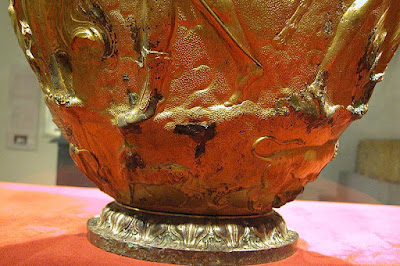The Derveni Krater, a masterpiece of Classical Greek metalwork
Derveni Krater, one of the most precious metal vessels from all of ancient Greece. It may well deserve its very own blog post in the future, but here we'll describe it in a few words: it is a bronze vessel, 90 cm (36 in) tall and weighing 40 kilos (88lb); its purpose is the mixing of wine and water at a symposion (the ritualised drinking party that was central to male social life); it probably dates to about 350 BC and was perhaps made in Athens or at least by an Athenian-trained craftsman. Its owner was a man called Astion, son of Anaxagoras, from Larisa in Thessaly (as an inscription on the top tells us). Presumably, the grave it was found in was his.
The krater is incredibly ornate, with extraordinarily finely traced decoration depicting the marriage of Dionysos (God of wine and various kinds of ecstasy) and Ariadne (she is linked to many of our tours), accompanied by Dionysos's entourage, satyrs and maenads, in wildly exuberant celebration. The detail of these dancing figures, their flowing and slipping garments, their expressions of ecstasy, their dynamism and their eroticism, is astonising.
Derveni (Greek: Δερβένι) is a location between Efkarpia and Lagyna, approximately ten kilometers north-east of Thessaloniki. At Derveni an archeological site is located where a necropolis was discovered, part of a cemetery of the ancient city of Lete. Valuable artifacts were uncovered at this site, including the Derveni papyrus and Derveni krater.
The Derveni Krater is a volute krater, the most elaborate of its type, discovered in 1962 in a tomb at Derveni, not far from Thessaloniki, and displayed at the Archaeological Museum of Thessaloniki. Weighing 40 kg, it is made of a bronze with a high tin content of about 15%, which endows it with a superb golden sheen without use of any gold at all. It is dated to the 4th century BC, and was probably made in Athens. Large metalwork vessels are extremely rare survivals in Ancient Greek art, and the Derveni Krater is the outstanding survival from Hellenistic art, as the Vix Krater is from the Archaic period.
The krater was discovered buried, as a funerary urn for a Thessalian aristocrat whose name is engraved on the vase: Astiouneios, son of Anaxagoras, from Larissa. Kraters (mixing bowls) were vessels used for mixing undiluted wine with water and probably various spices as well, the drink then being ladled out to fellow banqueters at ritual or festive celebrations. When excavated, the Derveni Krater contained 1968.31 g of burnt bones that belonged to a man aged 35–50 and to a younger woman.
The vase is composed of two leaves of metal which were hammered then joined, although the handles and the volutes (scrolls) were cast and attached. The main alloy used gives it a golden colour, but at various points the decoration is worked with different metals as overlays or inlays of silver, copper, bronze and other base metals. Such highlights include the silver garlands of vine and ivy around the krater, the silver and copper stripes on the vipers at the handles, and the silver ords of the eyes of the volute masks.
The top part of the krater is decorated with motifs both ornamental (gadroons, palm leaves, acanthus, garlands) and figurative: the top of the neck presents a frieze of animals and most of all, four statuettes (two maenads, Dionysus and a sleeping satyr) are casually seated on the shoulders of the vase, in a pose foreshadowing that of the Barberini Faun.
On the belly, the frieze in low relief, 32.6 cm tall, is devoted to the divinities Ariadne and Dionysus, surrounded by revelling satyrs and maenads of the Bacchic thiasus, or ecstatic retinue. There is also a warrior wearing only one sandal, whose identity is disputed: Pentheus, Lycurgus of Thrace, or perhaps the "one-sandalled" Jason of Argonaut fame.
The exact date and place of making are disputed. Barr-Sharrar thinks it was made around 370 BC in Athens. Based on the dialectal forms used in the inscription, some commentators think it was fabricated in Thessaly at the time of the revolt of the Aleuadae, around 350 BC. Others date it between 330 and 320 BC and credit it to bronzesmiths of the royal court of Alexander the Great.
The funerary inscription on the krater reads:
ΑΣΤΙΟΥΝΕΙΟΣ ΑΝΑΞΑΓΟΡΑΙΟΙ ΕΣ ΛΑΡΙΣΑΣ
The inscription is in the Thessalian, variant of the Aeolian dialect: Aστιούνειος Aναξαγοραίοι ἐς Λαρίσας (Astioúneios Anaxagoraīoi es Larísas), "Astiouneios, son of Anaxagoras, from Larissa." If transcribed in Attic, the inscription could read: Aστίων Aναξαγόρου ἐκ Λαρίσης (Astíōn Anaxagórou ek Larísēs).





.jpg)
.jpg)
.jpg)

.jpg)


Σχόλια